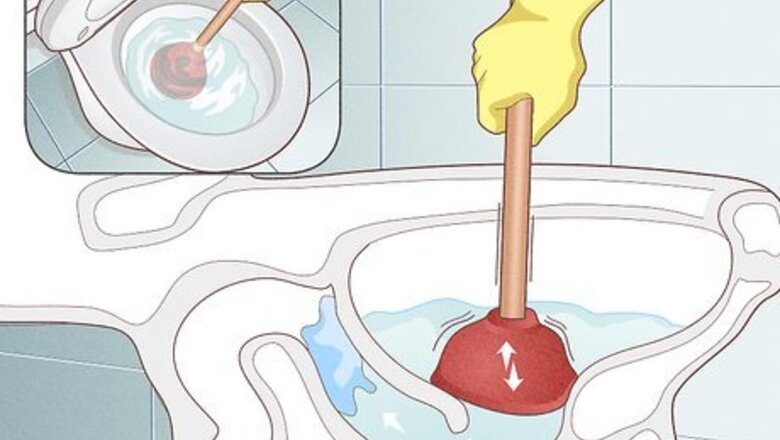
views
Plunging the Toilet

Insert the plunger into the toilet bowl. Make sure the plunger completely covers the hole. Submerge the plunger fully in the water so that you can push and pull water through the opening, not air. Add water from the bathroom sink to the bowl if there isn’t enough water to cover the plunger. Running the plunger under hot water can soften it, which can help it create a better seal. Hopefully your plunger has an “extension flange.” This is the rubber extension after the bell-shaped part of your plunger and it’s designed to better fit the toilet opening.

Pump the plunger over the hole. Push down gently at first, since the first plunge will push air into the bowl and could splash back. Then pull up sharply to disturb the clog and loosen it. Continue vigorously pushing and pulling until the water begins to drain. It may take 15 to 20 cycles before the toilet unclogs. Be patient. As long as you don't have a hard object (like a kid's toy) stuck in there, plunging alone often suffices. It might not work immediately but will often work after a few dozen plunge cycles.
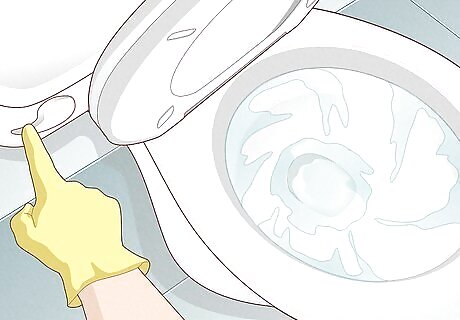
Flush the toilet to check the drainage. If the plunging eventually drains the bowl, but the clog is still blocking a free flow down the drain, leave the plunger in the bowl and fill the bowl with water again. Fill it to the point it is normally after a regular flush, then plunge again. Stubborn clogs might require you to do this a number of times. Flush the toilet 2-4 times once you’re done plunging to move the blockage through the sewer system.
Using a Toilet Brush (Plumber Recommendation)

If you don't have a plunger on hand, plumber James Schuelke recommends using a toilet brush instead.

Insert the toilet brush into the toilet bowl. Do your best to get the toilet brush to cover the porthole of the toilet.
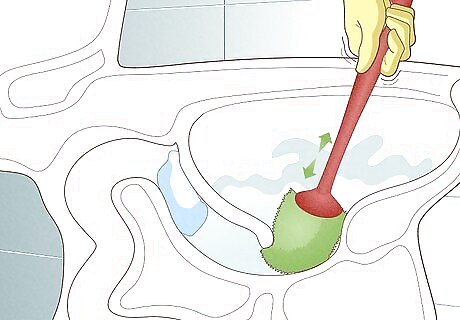
Move the brush back and forth inside of the porthole, as you would a plunger. According to James, it helps if there is some water in the bowl.
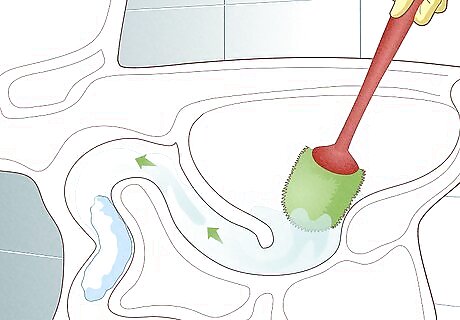
If you are successful with this method, the toilet will begin to drain.
Using an Unclogging Product
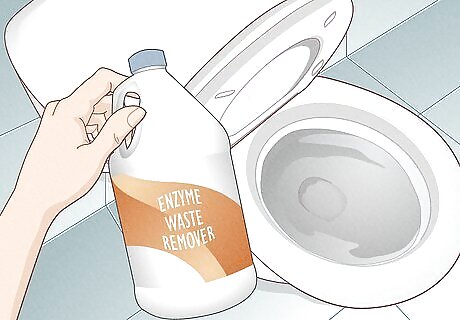
Purchase an enzyme waste removal product. Look for a product that contains a mixture of enzymes that liquify waste materials. These enzymes are used in septic systems to break down waste. Products of this sort can usually be purchased at home improvement stores in or near the plumbing aisle. Enzyme waste removal is preferable to using a drain-clearing chemical because it will not harm your pipes or the environment. This method will only work on organic waste, not toys or other objects.
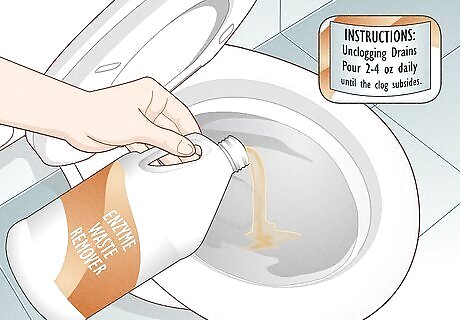
Follow the instructions on the container. Pour the recommended amount of the enzyme product into the toilet bowl. You will typically be instructed to wait overnight for the enzymes to go to work on the clog. The toilet should drain once the clog has cleared.
Making a Drain Cleaner

Heat half a gallon of water. Boil half a gallon of water, then let it cool for a moment while you add other ingredients to the toilet bowl. Use at least half a gallon. A small amount of water won't work, since it won't have enough force to push through the clog. The water should be no hotter than a hot tea you can drink comfortably. It should not be boiling, since very hot water can crack porcelain. You want to raise the temperature of the water passing around or pressing on the clog.

Pour 1 cup baking soda and 2 cups vinegar into the toilet. The baking soda and vinegar create a chemical process that help to dissolve clogs. Distilled white vinegar is commonly used, but any type of vinegar will work. The mixture will fizz a great deal. If you don't have baking soda and vinegar on hand, try adding a few squirts of dish soap to the toilet bowl. The soap may help to loosen the clog. This method isn't likely to work for clogs caused by a hard obstruction, such as a toy.

Pour the hot water into the bowl. Pour it from waist level, rather than right near the rim. The force of the water falling into the bowl can help to clear the clog.
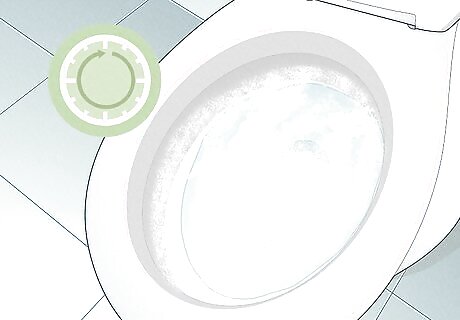
Let the mixture stand overnight. In the morning, the water should have drained. This homemade drain cleaner should successfully clear clogs caused by organic material. If the water won't flush on your second try, you may have hard obstruction causing the clog. Try using a wire coat hanger or a drain snake.
Making a Wire Coat Hanger Snake
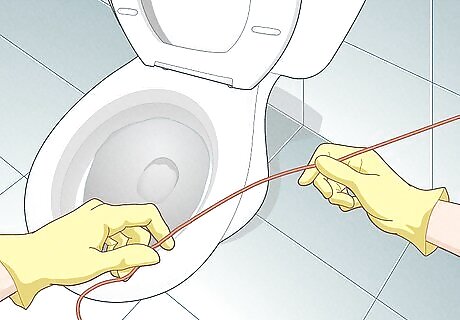
Unravel and straighten a wire coat hanger. Then wrap the end of the wire with a rag. Use duct tape to keep the rag in place. This will prevent the sharp end from damaging the porcelain in your toilet. The wire hanger method will generally work only if there is an obstruction in the first few inches of the drain.
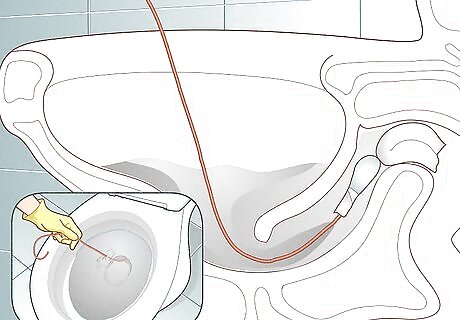
Stick the wrapped end of the wire into the drain. Once the wire is in the drain, twist it, push it, and maneuver it in a circular motion to clear the drain. If you can feel the obstruction, push against it. Keep going until the water begins to drain. Make sure you're wearing rubber gloves as you do this. You may get splashed as you move the wire around. If you can't feel an obstruction, and the toilet won't drain, the clog must be out of reach of the hanger. Try the plumbing snake method to clear it.
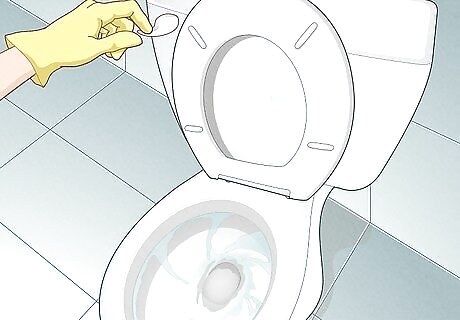
Flush the toilet once the water has drained. The obstruction and dirty water should now be able to flow through the drain like normal. If the toilet is still slow to drain, the obstruction may have gotten pushed further back, out of reach of the hanger. In this case you'll need to use a plumbing snake to clear it.
Using a Plumbing Snake
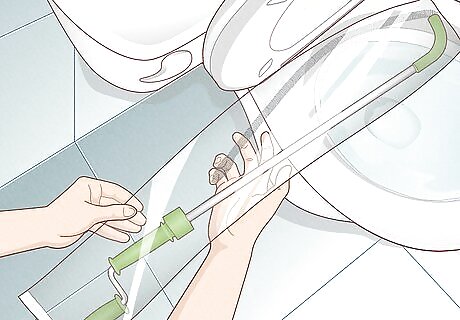
Purchase or borrow a plumbing snake. A plumbing snake (also sometimes called a "flexible cleaning tool" or "auger") is a flexible coil of wire that can "snake" through the curves of a drain and get deeper than a wire can. The best snake is a "closet auger" which is designed specifically to clear toilet clogs without damaging or staining the bowl.
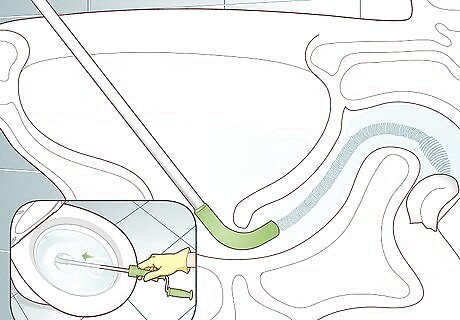
Insert one end of the snake into the drain. Push down, feeding the snake further into the drain until you feel an obstruction.
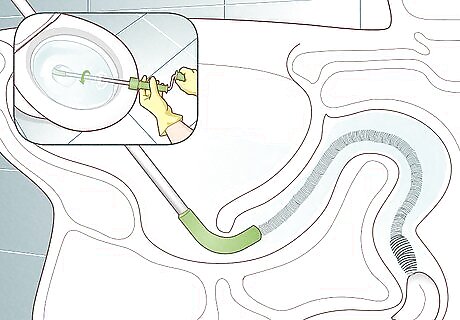
Twist and push the snake through the obstruction. The goal is to break up the obstruction into smaller pieces that can move through the pipes. It may take a few minutes of maneuvering to clear the obstruction. Once the water drains, flush the toilet to see whether it drains as quickly as normal. Crank the handle on an auger to push the wire through the clog.

Snake in reverse. It may become necessary to remove the toilet and run the snake through in the opposite direction. This is especially true with hard obstructions that may have been flushed by a curious child. If the obstruction is known to be hard and you are not comfortable removing and replacing the toilet, contact a plumber.
Utilizing a Wet/Dry Vacuum

Buy or borrow a wet/dry vacuum. If you have tried plunging and snaking to no avail, consider using a wet/dry vacuum. Do not use an ordinary vacuum cleaner––it must be the wet/dry variety that can cope with water.
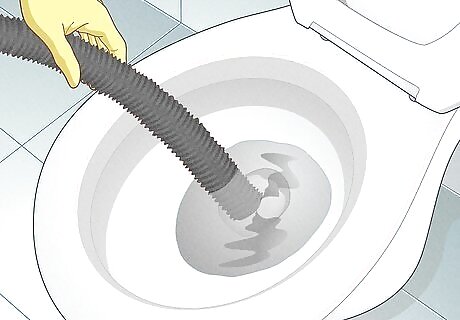
Empty the water out of the bowl using the vacuum. The bowl must be free of water and any other debris in order to vacuum out the obstruction.
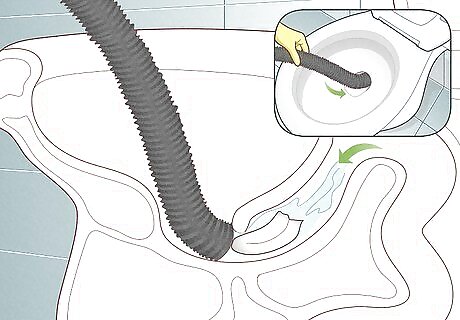
Place the end of the vacuum hose into the drain and turn on the vacuum. Push it into the toilet bowl a few inches into the hole. Use just the flexible hose, rather than an attachment. Coil an old towel around the hole to create a seal around the drain. There’s a good chance the vacuum can suck out the clog.
Using a Chemical Drain Cleaner
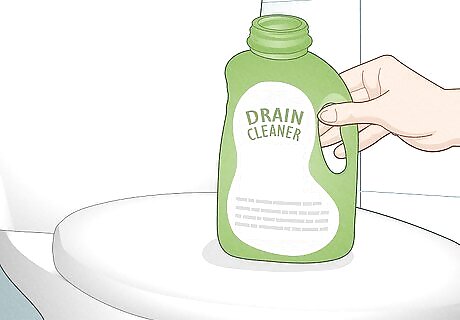
Purchase a chemical drain cleaner. They're available at most grocery, hardware, and "big box" stores. Only use chemical drain cleaners that are specifically made for toilets. Using other drain cleaners may damage your toilet. If you suspect that there is a hard obstruction, like a toy, do not use a chemical solution. Instead, use a snake or call a plumber. Never mix different chemical cleaners together as the result could be extremely dangerous or even fatal fumes.

Pour the specified amount into the toilet. Be sure you follow the manufacturer's instructions. Keep the lid down to prevent toxic fumes from filling your bathroom. Make sure the bathroom is well ventilated, so you won't inhale potentially dangerous chemicals.
Clean Up Tips

A used plunger (especially flange plungers) may still have water inside of it after plunging. Keep it over the toilet, turn it a bit, and shake it slightly to drain it so it won't drip on the floor. Disinfect the toilet bowl with a disinfectant cleaner after you've cleared the clog. Dispose of the wire (if used) and disinfect or dispose of the rubber gloves and any other tools (such as a plunger or snake) that you used. These tools can spread germs and start to stink if not properly cleaned. It’s best to mop and clean your bathroom after plunging a toilet. Even if you didn’t see and splash back out of the bowl.
Preventing Future Clogs

If your toilet gets clogged often, try to figure out what clogged the toilet and prevent it from happening again. Common culprits are too much toilet paper, tampons (some are flushable but most are not), toys (both kids and pets are suspects), cotton swabs, and baby wipes. Consider having a little "what not to flush" presentation in the best interest of your plumbing. Regularly clean the siphon jets around the toilet bowl's edge so that the toilet can flush at full power, making it less likely to clog. If your clog was from a child’s toy, invest in some toilet seat locks.
When to Call a Plumber

Before a clog: If you see (or hear) water backing up in the sinks or showers whenever you flush, that means there's a deep clog that will eventually stop your toilet from working properly. Call a plumber. If you smell gas coming from the toilet, it's best to get the plumber and your local electric/ gas company on the scene right away. It could be a cross-bore in the sewers.

















Comments
0 comment